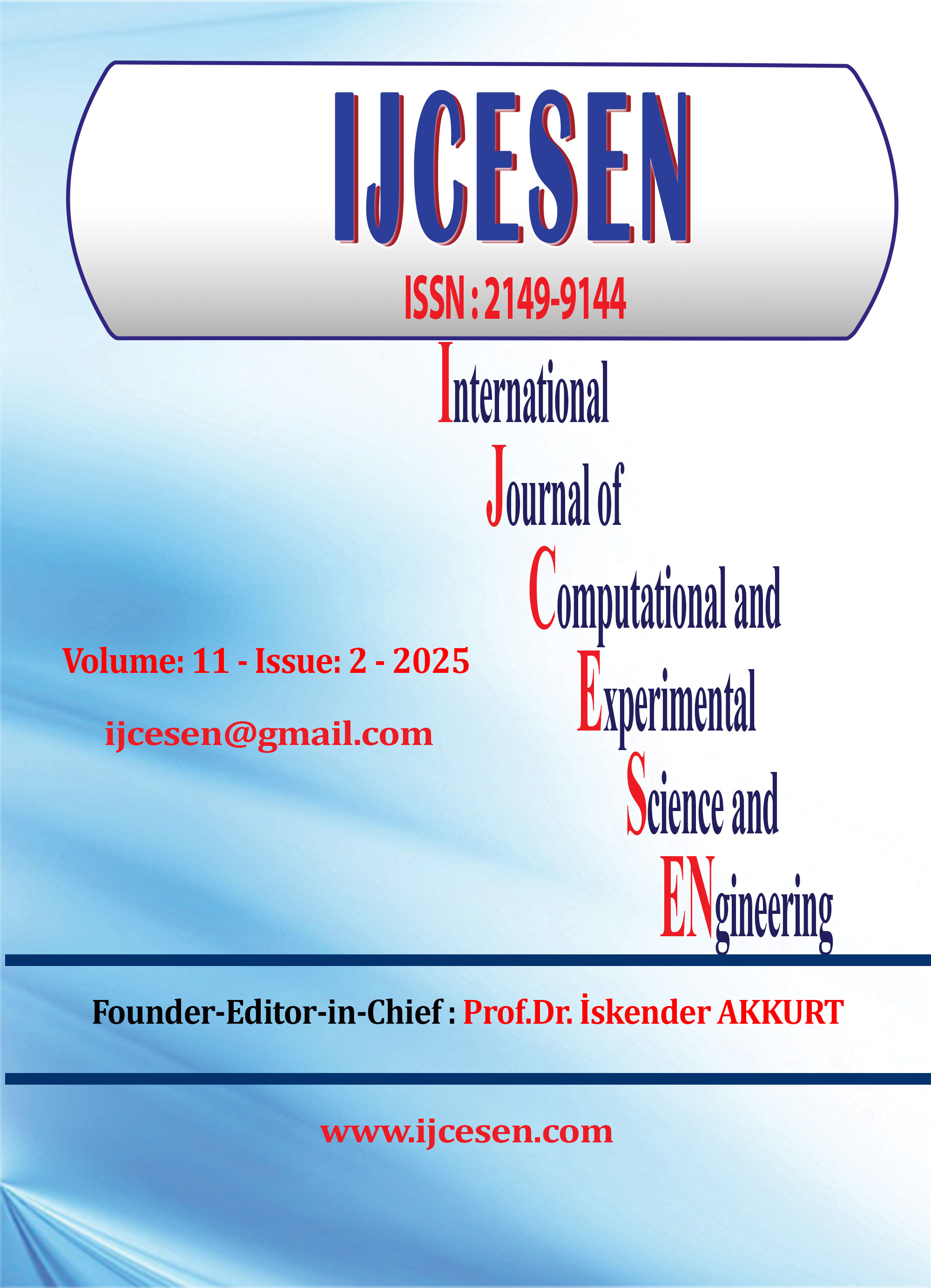Comparative Evaluation of Dimensional Accuracy Between Digital And Conventional Impression Techniques For Parallel Endosseous Dental Implants
DOI:
https://doi.org/10.22399/ijcesen.1454Keywords:
Digital Impression, Traditional Impression, Dimensional Accuracy, Parallel Implants, Intraoral Scanner, Polyvinyl SiloxaneAbstract
The precision of dental impressions is of utmost importance for the successful construction of implant-supported prostheses. This research compares parallel endosseous dental implant digital and conventional impression techniques in terms of dimensional accuracy.60 impressions (30 digital and 30 conventional) were taken on a master model with parallel implants. Digital impressions were taken with an intraoral scanner, and conventional impressions were taken with polyvinyl siloxane (PVS) material. The accuracy of both methods was assessed by comparing deviations in implant position and angulation with a coordinate measuring machine (CMM).Digital impressions had far lower mean deviations in implant position (25 ± 5 µm) than conventional impressions (45 ± 10 µm). The angular deviations were lower for digital impressions (0.2° ± 0.05°) than for conventional impressions (0.5° ± 0.1°). Detailed comparisons of linear and angular deviations were presented on six tables.Digital impression techniques demonstrated superior dimensional accuracy for parallel endosseous dental implants compared to conventional techniques.
References
[1] Papaspyridakos, P., Chen, C. J., Gallucci, G. O., Doukoudakis, A., Weber, H. P., & Chronopoulos, V. (2014). Accuracy of implant impressions for partially and completely edentulous patients: a systematic review. International Journal of Oral & Maxillofacial Implants. 29(4):836-45. https://doi.org/10.11607/jomi.3625 DOI: https://doi.org/10.11607/jomi.3625
[2] Lee, H., So, J. S., Hochstedler, J. L., & Ercoli, C. (2008). The accuracy of implant impressions: a systematic review. Journal of Prosthetic Dentistry. 100(4):285-91. https://doi.org/10.1016/s0022-3913(08)60208-5 DOI: https://doi.org/10.1016/S0022-3913(08)60208-5
[3] Giménez, B., Özcan, M., Martínez-Rus, F., & Pradíes, G. (2015). Accuracy of a digital impression system based on active wavefront sampling technology for implants considering operator experience, implant angulation, and depth. Clinical Implant Dentistry and Related Research. 17(Suppl 1). https://doi.org/10.1111/cid.12124 DOI: https://doi.org/10.1111/cid.12124
[4] Mangano, F., Gandolfi, A., Luongo, G., & Logozzo, S. (2017). Intraoral scanners in dentistry: a review of the current literature. BMC Oral Health. 17(1):149. https://doi.org/10.1186/s12903-017-0442-x DOI: https://doi.org/10.1186/s12903-017-0442-x
[5] Ahlholm, P., Sipilä, K., Vallittu, P., Jakonen, M., & Kotiranta, U. (2018). Digital versus conventional impressions in fixed prosthodontics: a review. Journal of Prosthodontics. 27(1):35-41. https://doi.org/10.1111/jopr.12527 DOI: https://doi.org/10.1111/jopr.12527
[6] Flügge, T. V., Schlager, S., Nelson, K., Nahles, S., & Metzger, M. C. (2013). Precision of intraoral digital dental impressions with iTero and extraoral digitization with the iTero and a model scanner. American Journal of Orthodontics and Dentofacial Orthopedics. 144(3):471-8. https://doi.org/10.1016/j.ajodo.2013.04.017 DOI: https://doi.org/10.1016/j.ajodo.2013.04.017
[7] Ender, A., & Mehl, A. (2013). Accuracy of complete-arch dental impressions: a new method of measuring trueness and precision. Journal of Prosthetic Dentistry. 109(2):121-8. https://doi.org/10.1016/s0022-3913(13)60028-1 DOI: https://doi.org/10.1016/S0022-3913(13)60028-1
[8] Patzelt, S. B., Emmanouilidi, A., Stampf, S., Strub, J. R., & Att, W. (2014). Accuracy of full-arch scans using intraoral scanners. Clinical Oral Investigations. 18(6):1687-94. https://doi.org/10.1007/s00784-013-1132-y DOI: https://doi.org/10.1007/s00784-013-1132-y
[9] Rödiger, M., Heinitz, A., Bürgers, R., & Rinke, S. (2017). Fitting accuracy of zirconia single crowns produced via digital and conventional impressions—a clinical comparative study. Clinical Oral Investigations. 21(2):579-87. https://doi.org/10.1007/s00784-016-1924-y DOI: https://doi.org/10.1007/s00784-016-1924-y
[10] Basaki, K., Alkumru, H., De Souza, G., & Finer, Y. (2017). Accuracy of digital vs conventional implant impression approach: a three-dimensional analysis. International Journal of Oral & Maxillofacial Implants. 32(4):792-9. https://doi.org/10.11607/jomi.5431 DOI: https://doi.org/10.11607/jomi.5431
[11] Chew, A. A., Esguerra, R. J., Teoh, K. H., Wong, K. M., Ng, S. D., & Tan, K. B. (2017). Three-dimensional accuracy of digital implant impressions: effects of different scanners and implant level. International Journal of Oral & Maxillofacial Implants. 32(1):70-80. https://doi.org/10.11607/jomi.4942 DOI: https://doi.org/10.11607/jomi.4942
[12] Alshawaf, B., Weber, H. P., Finkelman, M., Kudara, Y., El Rafie, K., & Papaspyridakos, P. (2018). Accuracy of printed casts generated from digital implant impressions versus stone casts from conventional implant impressions: a comparative in vitro study. Clinical Oral Implants Research. 29(8):835-42. https://doi.org/10.1111/clr.13297 DOI: https://doi.org/10.1111/clr.13297
[13] Vandeweghe, S., Vervack, V., Dierens, M., & De Bruyn, H. (2017). Accuracy of digital impressions of multiple dental implants: an in vitro study. Clinical Oral Implants Research. 28(6):648-53. https://doi.org/10.1111/clr.12853 DOI: https://doi.org/10.1111/clr.12853
[14] Giménez, B., Pradíes, G., Martínez-Rus, F., & Özcan, M. (2015). Accuracy of two digital implant impression systems based on confocal microscopy with variations in customized software and clinical parameters. International Journal of Oral & Maxillofacial Implants. 30(1):56-64. https://doi.org/10.11607/jomi.3689 DOI: https://doi.org/10.11607/jomi.3689
[15] Lee, S. J., & Gallucci, G. O. (2013). Digital vs. conventional implant impressions: efficiency outcomes. Clinical Oral Implants Research. 24(1):111-5. https://doi.org/10.1111/j.1600-0501.2012.02430.x DOI: https://doi.org/10.1111/j.1600-0501.2012.02430.x
[16] Abduo, J., & Elseyoufi, M. (2018). Accuracy of intraoral scanners: a systematic review of influencing factors. European Journal of Prosthodontics and Restorative Dentistry. 26(3):101-21. https://doi.org/10.1922/EJPRD_01752Abduo21
[17] Tan, M. Y., Yee, S. H. X., Wong, K. M., Tan, Y. H., & Tan, K. B. C. (2020). Comparison of accuracy of implant impressions using different techniques and materials. Journal of Prosthodontics. 29(1):14-20.
[18] Marghalani, A., Weber, H. P., Finkelman, M., Kudara, Y., El Rafie, K., & Papaspyridakos, P. (2018). Digital versus conventional implant impressions for partially edentulous arches: an evaluation of accuracy. Journal of Prosthetic Dentistry. 119(4):574-9. https://doi.org/10.1016/j.prosdent.2017.07.002 DOI: https://doi.org/10.1016/j.prosdent.2017.07.002
[19] Amin, S., Weber, H. P., Finkelman, M., Kudara, Y., El Rafie, K., & Papaspyridakos, P. (2017). Digital vs. conventional full-arch implant impressions: a comparative study. https://doi.org/10.1111/clr.12994 DOI: https://doi.org/10.1111/clr.12994
[20] Mizumoto, R. M., Yilmaz, B., McGlumphy, E. A., Seidt, J., & Johnston, W. M. (2020). Accuracy of different digital scanning techniques and scan bodies for complete-arch implant-supported prostheses. Journal of Prosthetic Dentistry. 123(1):96-104. https://doi.org/10.1016/j.prosdent.2019.01.003 DOI: https://doi.org/10.1016/j.prosdent.2019.01.003
[21] Albdour, E. A., Shaheen, E., Vranckx, M., Mangano, F. G., Politis, C., & Jacobs, R. (2019). A novel in vivo method for evaluating the accuracy of digital and conventional implant impressions. BMC Oral Health. 8(1);117. https://doi.org/10.1186/s12903-018-0580-9 DOI: https://doi.org/10.1186/s12903-018-0580-9
Downloads
Published
How to Cite
Issue
Section
License
Copyright (c) 2025 International Journal of Computational and Experimental Science and Engineering

This work is licensed under a Creative Commons Attribution 4.0 International License.





